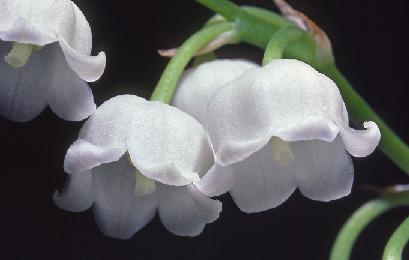Lily of the Valley
May Birth Flower
 |
The lily of the valley is a low-growing perenial plant that usually has two large oblong leaves and small fragrant nodding bell-shaped flowers. Lily of the valley is one of the most delicate and beautiful of the lily family. The flowers are normally white, although occasionally you can find some with a pink hue to them. By September the flower is producing sweet berries in place of the petals that are about 5-7 mm in diameter. Lily of the valley has also been used in herbal medicine as a poison antidote, for the heart and epilepsy. The plant contains various toxins that stimulate the heart and, if ingested in large quantities, can cause death. |
Physical Appearance and Characteristics
The flower can even take full sun in areas where temperature remain cooler in summer. It can spread quickly by underground stems called rhizomes. This plant is hardy in USDA zones 2 – 7. The somewhat tropical looking leaves of this perenial belie its ability to survive sub-zero temperatures. The leaves remain beautiful even after the spring blooms fade and cover areas where other plants fail. The blooms of this tough and reliable perennial are very fragrant. Lily of the valley gives off a large scent that attracts people as well as many insects such as bees who like to collect the pollen that the plant produces.
Technically lily of the valley is not a lily at all, the plant belongs to the botanical family Ruscaceae, not the Liliaceae (lily family). Most of them are low growing plants that can only reach about 8 inches tall. The flowers grow on stalks about 4 to 5 inches tall from the center of the plant. Plants live for decades in cool climates but will die quickly where summers are hot. It wont survive well in high-traffic areas.
A few other choices are also available such as the pink blossomed variety called Rosea and the taller variety called Fortin’s Giant which grows about 12 inches tall. Certain varieties of lily-of-the-valley has unusual variegated leaves. A cultivar named Albostriata have leaves with white stripes and Variegata have dappled leaves. There is also Aureovariegata, a variegated cultivar that has yellow stripes in the leaves.
Poison and Uses
It is also important to note that all parts of the lily-of-the-valley are poisonous and is dangerous if ingested. In the past, one of these toxins, convallatoxin, was widely used as a heart medication. The plant contains 3 glycosides; convallarin, convallamarin and convallotoxin. One of the most active natural substances affecting the heart is convallotoxin. It causes slow, irregular pulse rates and can cause heart failure. The plant also contains saponins which cause gastrointestinal poisoning.
Lily of the valley is sometimes cultivated as a source of perfume. The leaves have been historically used to produce green dye. Teas and ointments from this plant are used for burns, fever and as a sedative and diuretic.
Care Tips
One of the ways this flower is sold is by sprouts from the rhizomes called pips. The rhizome sprouts should be planted in the spring. Planting this plant in beds with other flowers is not a good idea because this tough perennial can spread quickly and will overtake the other plants and become a problem. A place that is enclosed with edging or other barriers is needed for the flower to contain its spread. Lily of the valley can become invasive in natural forest areas, so it is better to take care if planting near natural woodlands.
Lily of the valley prefers areas that are moist and well drained. Adding mulch to these plants along with occasional watering during periods of drought will keep them happy. A yearly application of fertilizer can be beneficial if they are growing under shrubs and trees. Constant moisture will keep these plants green throughout the growing season. Lily of the valley is not susceptible to insects. They can begin to get leaf spot and stem rot during very rainy seasons. Remove and destroy the infected parts immediately after they are noticed. These perennials will need to be divided occasionally to encourage better blooming. They prefer shade and will grow in most soil types. In autumn the bulbs are often dug up and stored for replanting in spring. Though it bears dozens of blossoms, Lily-of-the-Valley can only last for less than a week.
Meanings
Lily of the valley has the flower meaning of humility, chastity, sweetness, purity and is said to bring luck in love. It also means "the return of happiness" which is the reason why it is often used as decorations in weddings. Convallaria majalis or lily of the valley usually bloom in the month of May. This May flower is also known as the May lily. The alternate May birth flower is the lily of any variety. Lily of the valley is native to temperate areas of Asia, Europe, and North America, where it grows naturally in woodland settings. |
 |
Lilies of the valley appear in several Christian Bible stories. It is said that lilies of the valley grew from the spot where Mary's tears hit the ground at the foot of the cross.
Copyright © 2009 Game Frog
Home | Contact | Disclaimer | Privacy Policy